|
Updated Oct. 17, 2023 Minolta was one of the early players in the SLR market with the introduction of their SR-mount in 1958, only a year behind Asahi Optical Company's Pentax (which used the existing Praktica M42 screwmount), and a year ahead of the Nikon F-mount. More commonly known as the MD mount (which is really the designation of the fourth-generation lenses) the SR was a very advanced bayonet design for 1958 that required no internal changes for its 40+ year lifespan and thus avoided the compatibility problems suffered by most other concurrent mounts as they had to modernize or adopt completely new designs to offer auto-exposure capability and other new features. In 1985, when Minolta introduced its new Alpha (A) mount which permitted auto focus, the SR-mount was not immediately discontinued, but it was the beginning of the end, and by the mid-2000s it was an orphan. Which means great things for the bargain hunter. Orphaned mounts are in lower demand, generally, and therefore, it is less expensive to obtain lenses and accessories for them. Minolta glass is of excellent optical and build quality and equally at home on classic film SLRs or adapted for modern mirrorless digital cameras. So let's take a look at some of the best bargains around in vintage Minolta lenses. Minolta SR Lens Nomenclature There are four major generations of Minolta manual focus lenses with several sub-genres in each generation. The best explanation of these is to be found here (keep scrolling down to LENS CLASSIFICATION) on Dennis Lohmann's excellent website. The most basic delineations are: 1) SR (with preset aperture); 2) Auto Rokkor (AR) featuring automatic aperture, which were produced concurrently with the SRs from 1958-66; 3) MC Rokkor (Meter-Coupled) produced from 1966-76; and 4) MD Rokkor (Minimum Diaphragm) produced from 1977 and on, dropping the "Rokkor" part of the designation in 1981. Many MD lenses (especially zooms) produced from 1985 and on were sub-contracted out and are of inferior quality and not worth your time or money. Rokkor-X simply designates lenses for the North American market. There is no difference in quality or specification from Rokkor. MD Rokkors sometimes have slightly better coatings than MC's but the difference is not a big deal. You may also come across Celtic lenses, which Minolta offered as lower-cost alternatives to Rokkors from 1972-80. They used cheaper, more modular construction (although still excellent) and used single coatings as opposed to the superior multi-coatings of the Rokkors. However, most of them used the same optical formulas and, therefore, are capable of excellent performance. They were available in the following: 28/3.5, 28/2.8, 35/2.8, 50/3.5 Macro, 135/3.5, 135/2.8, 200/4.5 & 200/4, and the 100-200/5.6 zoom. Be careful on prices, nowadays Celtics are often priced the same as or higher than Rokkors. But, if the price is right, there's nothing wrong with a Celtic. Unless stated otherwise, all lenses have a 55mm filter thread. Wide Angle MC/MD Rokkor 28mm f/3.5 (5-element version) The first 28mm SLR lenses introduced by the Japanese manufacturers had maximum apertures of f/3.5 due to the limitations of lens design and materials in the early 1960s. However, by the mid-1970s advances had been made and f/3.5 became the budget aperture and these lenses featured simpler optical formulas and smaller physical dimensions. As an example, Minolta's own design of the 28/3.5 went from 7 elements in 7 groups, 345 grams (12.2 oz), and 67mm filters in 1963, to 5 elements in 5 groups, 220 grams (7.8 oz), and 55mm filters by 1975. And the newer lens offered better optical performance to boot and halved the minimum focusing distance to 0.3m (12"). And so it is the 5-element version that is our bargain of choice in the 28/3.5 category. It was introduced in 1975 in MC Rokkor form (the 28/3.5 was not sold in North America so there are no Rokkor-X-labelled copies) and went through 4 different types of mechanical construction (MC Rokkor, MD Rokkor w/ 55mm filter ring, MD Rokkor w/ 49mm filter ring, and, finally, Plain MD). The most desirable of these from a build quality standpoint are the MC and first MD Rokkor (55) versions. From the second MD Rokkor (49) generation, cost-cutting had come (as with other manufacturers) to compete in the new mass consumer SLR market pioneered by the Canon AE-1. These later lenses still offered the same optical performance and lighter weight, but have more modular construction (read: less repairable, but easier to produce) and substituted less expensive materials in certain areas (read: more plastic). The original MC Rokkor version had an aluminum-on-brass helicoid while all subsequent versions used aluminum-on-aluminum. The optical performance of the 5-element 3.5 equals that of the more common and somewhat pricier 28mm f/2.8 MC Rokkor (7e/7g) that was also introduced in 1975 (aside from the 2/3-stop slower aperture, obviously). You can find examples in excellent condition for $40 - $50 USD. It was also available as a Celtic lens (more basic coatings and a ribbed focusing ring). 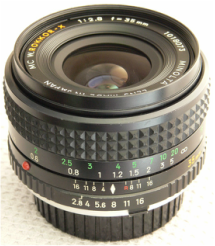 35/2.8 MC Rokkor-X 35/2.8 MC Rokkor-X MC/MD Rokkor(-X) 35mm f/2.8 (5-element version) Minolta introduced its first 35/2.8 in 1959 with a 7 elements in 6 groups configuration (designated with the HG prefix on the filter ring). In similar fashion to the 28/3.5, a simpler, lighter, and optically superior 5-element design was brought out in MC Rokkor form in 1975. The minimum focusing distance was trimmed by 10cm (4") to 0.3m. Again, the remarks on build quality for the 28/3.5 apply here. The best versions are the MC and first-gen MD (55mm filter) Rokkors. Optical quality is fine with the later versions (49mm filter) and if you are looking for the least amount of weight (40-55 grams (1.5-2 oz) less), they may be a better fit for you. Excellent copies can be had for $60 - 80 USD. The 35/2.8 was also available as a Celtic lens. Normal Lenses MD Rokkor(-X) 45mm f/2 (Pancake) This little guy has an interesting reputation. On film it's not anything spectacular, but many rave about its performance on digital, particularly crop-sensors (which would make sense, mostly due to using the sweet-spot of the lens, leaving the worst of the corners out). Introduced in 1978 as a cheap, compact kit lens for the new XG-series of cameras, the 45/2 weighs a minuscule 125 grams (4.4 oz) and is 30.5mm (1 1/4") long. If you are looking for the smallest, lightest Rokkor, this is it. The minimum focusing distance is 0.6m (24"), which is nothing to write home about, but was a trade-off for the compact dimensions and budget status of the lens. Prices are well under $40 USD and often with an XG body attached. 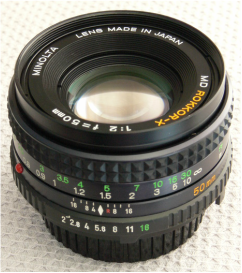 50/2 MD Rokkor-X from an SRT-200 50/2 MD Rokkor-X from an SRT-200 MC/MD Rokkor(-X) 50mm f/2 This was the kit lens for the budget-priced SRT 100, 100b, 100x, and 200 SLRs. It was not available separately, although you can find them so nowadays :-). It used the same 6 elements in 5 groups optical configuration as the 50/1.7, but differed in mechanical construction, having more in common with the Celtic line of lenses. It used a five-bladed aperture as opposed to the 1.7's six-bladed iris, but did have full multi-coating. The minimum focusing distance of 0.5m (20") is 5cm (2") more than the 1.7 MD Rokkor. Build quality is very impressive for a budget 50mm lens and optical quality is excellent. Prices are around $40 USD and as with the 45/2 often come with a body (usually one of the above SRTs) for that price (a steal!) In 1981, Minolta brought out a Plain MD 50/2 with the same minimum focusing distance and six-blade aperture as the 1.7s and it replaced the 45/2 as the cheap kit lens with the XG and X-series cameras. Prices are sometimes even lower for this version, $25 - 30 USD. 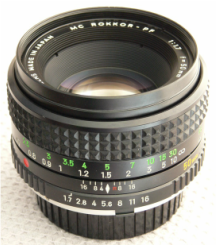 50/1.7 MC Rokkor - PF 50/1.7 MC Rokkor - PF MC/MD Rokkor(-X) 50mm f/1.7 Minolta brought its first 50/1.7 moderate aperture lens to market in 1973. This was the bread & butter 50 in the lineup, offering the best balance of performance/dollar. The basic 6 elements in 5 groups design did not change to the end of production, although some tweaking was highly probable along the way. Coatings were definitely improved through time. The MC Rokkor PF has a gorgeous feel to the focusing ring and has a heavier construction than the succeeding MD Rokkor. With the MD Rokkor's introduction in 1977, cost-cutting began. 45 grams of weight came off (mostly from the focusing assembly, aperture assembly, and lens barrel). The aperture ring was now plastic (it still works just as smoothly) and the lens blocks could no longer be completely disassembled. Optical performance was as good or even better, though. In 1978 a further 35 grams was removed and the filter ring became 49mm instead of 55. Mechanically, things had been reduced as far as they could reasonably go. If you favor build quality, the MC Rokkor is your lens. However, I have gotten some of my sharpest photos with a first-gen (55mm filter) MD Rokkor :-). Sample variation will probably have more effect on image quality than MC vs. MD construction. You can pick up any of the variations for $40 USD for one in excellent condition. Performance from f4 will equal the 50/1.4s. 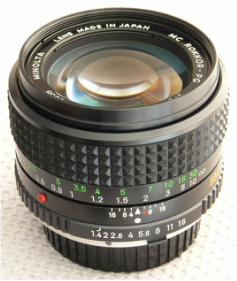 50/1.4 MC Rokkor - PG 50/1.4 MC Rokkor - PG Minolta MC Rokkor(-X) PG 50mm f/1.4 This is one of the best 50/1.4 lenses made by any manufacturer. So its going price of around $80 USD makes it a great bargain. The 1.4 PG shares its basic optical formula with the truly legendary MC Rokkor PG 58/1.2 (7e/5g). It does not have the killer bokeh of the 58, but what it does have is incredible sharpness from f2 onward. F/2.4 makes for an excellent setting where the nervous wide-open bokeh calms down and resolution and contrast really come together. In later iterations of the 50/1.4, Minolta strove to balance the performance of the lens more evenly, and they succeeded, but lowered the wide-open central sharpness just a bit to do so. The PG was produced from 1973 to 1976, right at the peak of Rokkor build quality. Focus and aperture rings are silky smooth and the lens just oozes craftsmanship. Minolta MD Rokkor(-X)/MD 50mm f/1.4 With all of the praise that the MC Rokkor PG gets, it's easy to overlook its successors. But they are marvelous lenses in their own right, and if you like having resolution, sharpness, bokeh, and contrast in a nice balance, the MDs might be preferable. The first-generation MD Rokkor (1977) also shared the 7e/5g layout of the PG (and the 55mm filter diameter), but was a new design. The designers wanted to remedy the nervous wide-open bokeh of the PG, and so made some adjustments in aberration correction to do so. Opticswise, the MD can totally hang with the MC and the bokeh is less busy wide open. Buildwise, the MD is definitely a step down, but it is still a very well-built lens. In 1979, the second-gen MD Rokkor appeared with a new 7e/6g design and further weight reduction (to 220 grams and 49mm filter size) from the 305 grams (11 oz) of the MC and 245 grams (8.6 oz) of the first-gen MD Rokkor. This optical formula held through the Plain MD and the end of production. All MD versions focus 5cm (2") closer than the 0.5m (20") of the MC. Prices are the same as the MC Rokkor PG, around $80 USD for examples in excellent condition. So you can make your choice based on build quality, size & weight and find a Minolta 50/1.4 to match, confident that they all will hold up their end optically. Minolta MC Rokkor PF 55mm f/1.7 This was the standard kit lens for the SRT-101 (1966), the camera that really put Minolta on the map. It's a very well balanced lens that cranks up the image quality by f/4. It is the predecessor of the MC Rokkor 50/1.7, sharing the 6 elements in 5 groups layout. There were two generations of the 55/1.7, which can be differentiated by the focusing grip. Both have knurled metal rings, but the second-gen (1970-73) has a "hill-and-valley" profile instead of the "flat" profile of the first-gen. The second-gen is the more desirable of the two, because, following the installation of Minolta's first lens computer in 1968, they recalculated the optical design of the 55/1.7 and made some improvements. Build quality is simply superb, right up there with Pentax Takumars. This lens makes for a great portrait length on APS-C sensor mirrorless cameras, with a wonderful vintage look and feel. Some 55/1.7s can develop an oily aperture, so be sure to inspect or verify from the seller that the aperture is snappy and clean. It is not too difficult to clean the aperture if you are comfortable with lens disassembly, and sometimes you can score a real deal on a sticky 55/1.7. Prices range from $30 - 50 USD. Minolta MC Rokkor PF 55mm f/1.9 The 55/1.9 is a quirky little lens that was the first Rokkor with a rubber grip (not the same style as later Rokkors) and was dimensionally and mechanically unique at its introduction in 1971 as the original kit lens for the budget-level SRT-100. (It was soon replaced by the MC Rokkor 50/2 in 1973.) It also eschewed the multi-coating of the standard Rokkors for single coatings. You could say that it served as a prototype for the Celtic line of lenses first introduced in 1972. Prices run the same as the MC Rokkor 50/2, around $30 - 40 USD. Definitely usable, if not spectacular, befitting a budget kit lens. 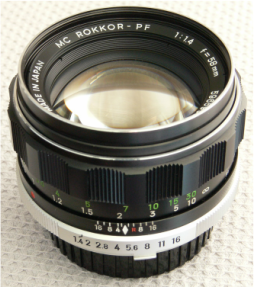 58/1.4 MC Rokkor "hill & valley" 58/1.4 MC Rokkor "hill & valley" Minolta MC Rokkor PF 58mm f/1.4 One of the true classics of the Minolta line. The 58/1.4 was first introduced in Auto Rokkor form in 1961 and culminated in the final "hill-and-valley" MC Rokkor version of 1969. It is the latter that is the most desirable, for it went through the same recalculation process as the 55/1.7 and the performance of the lens was noticeably improved. It renders black & white beautifully, and definitely gives that vintage feel to photographs. It was pushing the limits of the 6-element PF design to have an f/1.4 maximum aperture. So when the 58 is wide open it cannot compete with the 7-element MC/MD 50/1.4s at the same setting. But the softness at f/1.4 can be used very effectively for portraits and other effects because detail is retained. By f/2.8 - f/4 the sharpness really starts to come on. This is a lens that just makes you want to take pictures. Build quality is classic MC Rokkor, meaning smooooth focusing and a positively delicious silver aperture ring. Nothing looks as good on an SRT :-). The price is the same as the other f/1.4 normal lenses, running around $80 USD for copies in excellent condition. 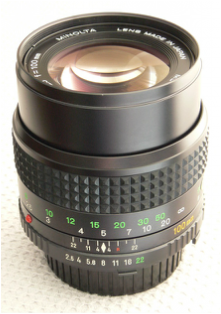 100/2.5 MD Tele Rokkor-X 100/2.5 MD Tele Rokkor-X Telephotos Minolta MC/MD Rokkor(-X)/MD 100mm f/2.5 (5-element version) The legendary MC/MD Rokkor(-X) 85mm f/1.7 tends to get the most attention among portrait-length Minolta lenses because of its performance, that big maximum aperture, and the design similarity to the uber-legendary MC Rokkor(-X) 58/1.2. And it is priced accordingly ($400 USD for excellent copies). The 100/2.5 flies under the radar as a result. Although it is not a bargain on the level of the other lenses we have looked at so far, compared to the 85/1.7 it's a steal at $150 USD. Introduced in a 6 elements in 5 groups PF configuration in 1968, it replaced the 100/3.5 and the semi-mythical but fragile 100/2. In 1976 a new 5-element design was brought out with improved performance. The 6-element design was very good but the newer 5-element is excellent from wide open on up. And it focuses 0.2m (8") closer. It is also 80 grams (3 oz) lighter and 6.5mm (1/4") smaller in diameter than the 85/1.7. This is a true sleeper of a lens. FYI, the Rokkor versions all have a looonngg 298-degree focus throw, which was shortened to a still-ample 200-degrees or so on the New MD version that also dropped to a 49mm filter size from 55mm. Minolta MC/MD Rokkor(-X)/MD 135mm f/3.5 A half-stop slower than the popular f/2.8 lenses, the f/3.5s get little respect. Which makes them an even better bargain! With less weight and size and sometimes identical performance 135/3.5s are some of the best lens bargains anytime, anywhere. And the Minolta 3.5s are no exception. First introduced in a 4 element in 4 groups MC Rokkor QD design in 1966 that didn't change until 1979, the 135/3.5 weighed 80 - 115 grams (3 - 4 oz) less than the comparable 135/2.8. And in 1979, the new 5-element MD Rokkor version dropped 155 grams (5.5 oz) more, and with improved optical performance, making it and the final Plain MD our recommended choice for a bargain 135/3.5 lens. And at a price around $50 USD, it definitely qualifies for that status! The older versions can be had for $40 USD so that's not too shabby, either. They are also available in Celtic form. 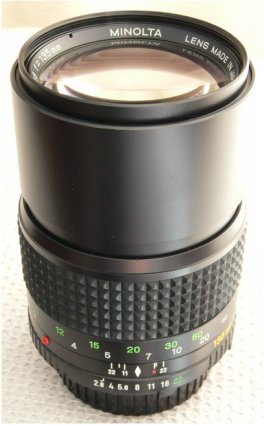 135/2.8 MD Tele Rokkor (4/4) 135/2.8 MD Tele Rokkor (4/4) Minolta MC/MD Rokkor(-X)/MD 135mm f/2.8 Although not as much of a bargain as the f/3.5s, 135/2.8s are still a good deal nowadays and the Minolta 135/2.8s are a steal compared to other brands such as Canon FDs or Olympus OM Zuikos that offer no advantages in performance or build quality. There are two versions that we recommend as the best 135/2.8 bargains from Minolta: the 4e/4g introduced as an MC Rokkor(-X) in April 1975 and that continued through the first two MD Rokkor(-X) generations, and the 5e/5g late-MD Rokkor/Plain MD version first seen in 1979. The 4-element is considered the strongest 135/2.8 Minolta ever made with high refractive index glasses to combat CA (chromatic aberration). In magazine tests of the day, only the Leica-R 135/2.8 slightly bested the Rokkor. The price for such performance is weight, 535 grams (19 oz) worth of it :-). The 5-element version offers very nearly the same performance but at a relatively svelte 365 grams (13 oz). Both versions run at an average of $100 USD although you can find them for less with a little patience. They were also available as Celtic lenses with the same optics but lesser coatings.  200/4 MD Tele Rokkor 200/4 MD Tele Rokkor Minolta MC/MD Rokkor(-X) 200mm f/4 Our final prime lens bargain is the 200/4 introduced as an MC Rokkor in December 1975. Minolta again, as with the 100/2.5, replaced two lenses (the 200/3.5 and the 200/4.5) with one that outperformed its ancestors. The 200/4 is very, very good at wide open and excellent from f/5.6-f/11. 200/4s fell out of favor with the arrival of the first decent 70/75/80 - 200/210 zooms in the mid-to-late '70s. What photogs often didn't realize was that most of these zooms were considerably weaker in performance at the 200/210 end, and particularly compared to a prime lens. For the bargain hunter, this is a boon, for you can pick up one of these unloved, underrated beauties for around $100 USD, nowadays. The MC and first two MD Rokkor generations have the best build quality, with the final MD Rokkor and Plain MD versions sacrificing some of that quality for a 120 gram (4 oz) weight reduction from the 520 grams (18 oz) of their forebears. The minimum focus distance of 2.5m (8') is average, but not class-leading. Zooms Minolta MD Zoom Rokkor/MD Zoom 35-70mm f/3.5 This was the first standard zoom that could give prime lenses a run for their money in image quality. It first appeared in 1978 and went through two more permutations. The second generation was given some optical and cosmetic tweaks and is easily differentiated by the plastic zoom ring instead of the original's metal ring with two rows of the standard rubber waffle grip. The third-gen version was given a macro mode and focused 0.2m (8") closer. This makes it the most desirable model for many people, and therefore, it has the highest price of the three versions, around $150 USD. If you happen to be a video shooter, though, some of the second-gen models have a feature that you may find very useful. The first-gen version had a metal aperture ring with a slotted screw that held a tiny ball bearing that provides the click-stop action for the aperture ring. This feature was carried over for some time in second-gen production before the aperture ring was changed to a monolithic plastic construction with no easy access to the ball bearing. So you can get an optically-improved second-gen lens with an aperture ring that can be converted to clickless operation in about 30 seconds by carefully removing the screw and ball bearing and then replacing the screw (and this is completely reversible, as long as you don't lose the ball bearing ;-)). Second-gen lenses sell for about $80 USD. If you plan to use a 35-70/3.5 for a lot of video, you will want to add a little (VERY little!) high viscosity grease to the aperture ring track to provide some damping for smooth aperture control. All versions are parfocal, meaning that they maintain focus as they are zoomed and take 55mm filters. This was one of the lenses that Leica adopted from Minolta during their collaboration. The bargain status of the Minolta is confirmed by the sometimes ludicrous prices paid for the Leica R versions. Averaging $350 USD, it's not unusual to see them go for twice that or more ;-). 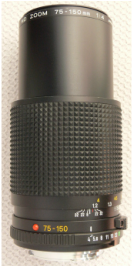 Minolta MD Zoom 75-150mm f/4 An uncommon and very underrated lens, perhaps because of its moderate 2x zoom ratio and f/4 aperture. But those moderate specifications made it possible to achieve a very high level of image quality and correction with a relatively simple and compact (49mm filter size) design. It also saves a considerable amount of weight (190 grams or 6.7 oz) and size (8mm or 3/8" dia. & 40mm or 1 9/16" of length) over the 70-210/4. It is a one-touch design and can be found easily for $75 USD and often less. Minolta MD Zoom 70-210mm f/4 Another of Minolta's designs to be adopted by Leica and which Minolta carried over into the auto focus era (the famous "Beercan"), the 70-210/4 (1983) was a far superior replacement for the 75-200/4.5 of 1978. This is not a small lens, but the performance is commensurate with its physical size :-). It takes the standard 55mm Minolta size of filters. Not to be confused with the later, smaller, and vastly inferior 70-210 f/4-5.6. If you can handle the size and weight, this is a great deal at $90 USD. References: The Minolta SR System @ http://minolta.eazypix.de/ The Rokkor Files @ http://www.rokkorfiles.com/ Minolta Lens Chronology @ www.thesybersite.com
28 Comments
B. Walter
8/9/2019 10:06:27 pm
excellent commentary and reviews!
Reply
C.J. Odenbach
8/9/2019 10:57:03 pm
Thanks for the feedback, B. I really appreciate it. Take care.
Reply
I have amassed a collection of Minolta glass.(I will not bore you with the list, unless you ask) I love using it on my A7 and A77, with a few adapters all is good. Thank You for all of the info, if it was not for guys like you a guy like me has trouble making decisions. My latest purchase was a RF250/5.6 -mint for 250 cad. Now that's a deal!
Reply
C.J. Odenbach
9/8/2019 09:15:42 am
Hi Randy,
Reply
Mark Jones
12/31/2019 03:35:23 pm
Hi,
Reply
C.J. Odenbach
12/31/2019 05:40:13 pm
Hi Mark,
Reply
Nighiri
7/26/2020 08:29:55 am
I have a Minolta SRT100. Do you think that the md zoom 35 70 will work good with it?
Reply
C.J. Odenbach
7/26/2020 12:28:18 pm
Hi Nighiri,
Reply
Howie Dewing
2/5/2021 07:41:42 pm
A remarkable lens from the twilight of manual focus days is the "Minolta" 28-70mm f/3.5-4.8 MD Zoom. Despite (or thanks to) Cosina or Tokina being the probable makers of this nevertheless Minolta-badged lens, it's actually quite good for a primordial 3:1X kit lens. I see vibrant images and good color rendition even on my FF mirrorless 24MP camera, and, well, yes, some aberrations wide open at certain focal lengths. My Zeiss 24-70mm crushes it optically, and could easily crush it physically, but at 60 bucks, it's worth a try. On a camera, I mean, not crushing it with a $2000 Zeiss. There are two versions of this lens, a light (225g.) and a heavy (361g.) one. Mine is the light one and is pure plastic in construction, with only a metal bayonet mount. I'm still looking for Minolta's highly touted f/3.5-4.5 28-85mm zoom, but this will have to do for now.
Reply
C.J. Odenbach
2/6/2021 12:35:15 pm
The 28-70 3.5-4.8 is a decent lens and if you can get it cheap or as a throw-in with a body, I wouldn't argue with it. It sounds like you have a good copy, Howie, and the lightweight version seems to be better optically than the heavier one, at least with the samples I have seen. However, I suspect that there is a wider sample variation with this lens than most original Minoltas. It was definitely designed as a kit lens, which usually means a pretty good bang for the buck, but not outstanding. Best wishes on your pursuit of an MD 28-85 3.5-4.5.
Reply
tom
5/17/2021 03:10:32 pm
I have a 24-50 rokkor x that I bought new back in the day--great results on film. Your thoughts?
Reply
C.J. Odenbach
5/17/2021 07:04:24 pm
That's an excellent lens you have there, Tom. One of the few proper wide angle zooms available starting in the late '70s. And with build quality to match. It absolutely destroys the later cheap AF version both optically and mechanically. One cannot reasonably expect it to hang with a prime in the corners unless you stop it down to f/8, but the central sharpness is very good to excellent even wide open. You can't beat it for the versatility of having 4 focal lengths (24, 28, 35, and 50) at your fingertips. As far as good vintage Minolta zooms go, it is the least "bargainy", but at current prices of $250 USD or so for an excellent copy, it's not even close to being overpriced, seeing as it sold for $825 USD new in 1981. They are getting harder to find in excellent condition nowadays, so I would say you have yourself a real keeper, especially if you like the results. Best regards.
Reply
Tricot
11/16/2021 01:03:51 pm
Good evening,
Reply
C.J. Odenbach
11/16/2021 03:20:12 pm
Glad to hear you are enjoying the website, Tricot. I will try to answer your questions as best I can for the parameters you specified.
Reply
Mickael Tricot
11/17/2021 01:17:23 pm
Good evening, yes it does!!!! many many thanks for spending so much time answering me.
Reply
C.J. Odenbach
11/17/2021 04:43:29 pm
Hi Mickael,
Reply
Tricot
12/6/2021 12:53:55 am
Hi,
C.J. Odenbach
12/6/2021 08:12:06 am
Thank you for sharing your comment below, Mickael. I could not reply to it directly, so that's why this reply is placed above it. I hope you enjoy your XD and your journey with Minolta :-). Take care.
Charl Pienaar
5/6/2022 11:06:29 pm
Good day,
Reply
C.J. Odenbach
5/7/2022 02:10:01 am
Thank you for the kind words, Charl. And great question about the relatively rare 53/2 Auto Rokkor.
Reply
John
7/16/2022 11:33:53 am
Hi Mr. Odenbach. If you have time I'd appreciate it if you could give me your opinion on it. Crib-notes: I was into 35 mm back in the 70 to 80's +/-. Started w/ a minolta srt 100 & 3 lenses. Inherited my dad's X-700 and his 3 lenses. ( I still used my 100 a lot. I was so use to it) So both MC, MD, & Sigma & Tamron zooms. Now that I'm retired, I'd like to buy a not to expensive (used) mirror-less body (budget- $300-750) to use with the lenses. Been reading for several weeks now so I have a very small amount of knowledge, just enough to get a guy in trouble.
Reply
C.J. Odenbach
7/16/2022 05:09:45 pm
Hi John. Thanks for reaching out. I am intimately familiar with having just enough knowledge to get myself in trouble ;-). Thanks for including details on your intended usage of a mirrorless body.
Reply
1/25/2023 08:14:33 pm
I have a half-dozen types of Minolta lenses, mostly older versions, some of which are mentioned in your article. I find myself going back to the 50mm f1.7 and 135mm f3.5. They are tiny and just marvelous, especially on a smaller body like the X-700. But your comment on the looks of the 58mm f1.4 on an SR-T body is spot on. That's what I think of when I think Minolta. Maybe that's saying something about how old I'm getting!
Reply
C.J. Odenbach
1/25/2023 11:25:45 pm
I couldn't agree more, Gil. The 50/1.7 and 135/3.5 are also two of my all-time Minolta favorites, especially the 5-element pocket-rocket 135s. So easy to chuck in a daypack. And they can still be had for peanuts!
Reply
Patrick Lowe
6/29/2023 06:41:08 pm
My question is that the Minolta 55mm has two lens system in which A) is the F1.7 and B) is the F1.8. What is the difference between this two and which one you think is better or in your opinion which one do you prefer. Thank you
Reply
C.J. Odenbach
6/29/2023 07:49:40 pm
Great question, Patrick. Minolta produced the 55/1.8s in Auto Rokkor form in three iterations from 1958 - 1965 and the 55/1.7 in MC Rokkor guise in two iterations from 1966 to 1973. Minolta was basically playing a bit of a numbers game when they chose to re-label their middleweight normal lens as an f/1.7 instead of f/1.8. It was the same optical design that they were tweaking throughout the 1960s.
Reply
Patrick Lowe
7/23/2023 02:21:25 pm
This is my second question for the 55mm F1.8 while the first one I asked about the difference between F1.7 and F.18 which you gave me a very detailed comments and I appreciated that. The second one, every one mentions that the F1.7 and F1.8 (55MM) using the same Six blades but my copy Auto Rokkor -PF F1.8 # 2434602 has Eight blades which in my opinion far better than my another Minolta 58mm F1.4 with the same period. In the meantime, I have also ordered a F1.7 based on your comment as well as a F1.2 so now I will; have the full set of Minolta 50s'. Thank you again for your advice.
Reply
C.J. Odenbach
7/23/2023 05:03:38 pm
Hi Patrick. Glad to hear you are completing your set of 50s :-).
Reply
Your comment will be posted after it is approved.
Leave a Reply. |
C.J. OdenbachSuffers from a quarter-century and counting film and manual focus SLR addiction. Has recently expanded into 1980's AF point and shoots, and (gack!) '90s SLRs. He even mixes in some digital. Definitely a sick man. Categories
All
Archives
June 2024
|
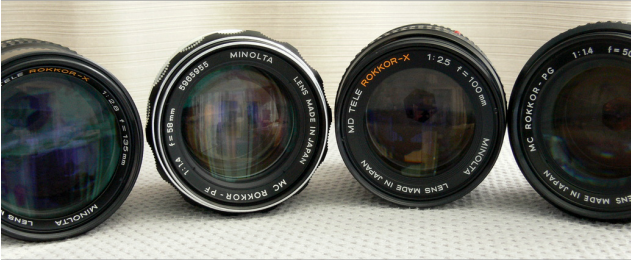
 RSS Feed
RSS Feed